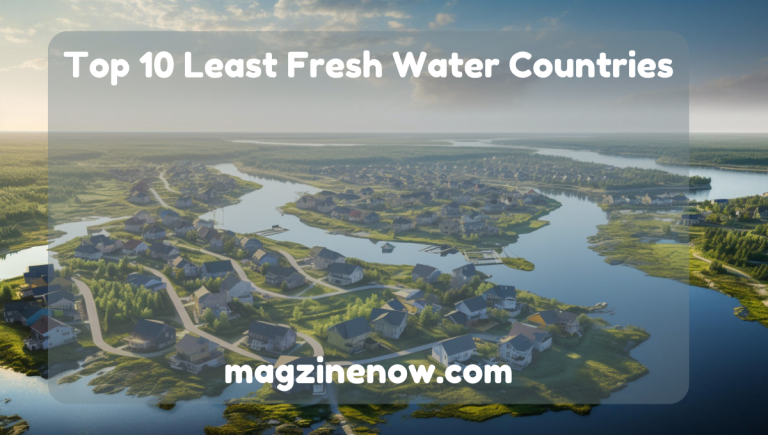Water is an essential factor for the health and productivity of any country especially that which is derived from a freshwater source. This influences the availability of drinking water, land use, commodity production, and social welfare. Nonetheless, several countries are in a very delicate position because they are badly affected by freshwater resource scarcity. I present the top ten global countries least endowed with fresh water and look at the reasons and impacts of water shortage in these ten regions.
Kuwait
Kuwait occupies a rank among the driest countries globally, having no lasting natural rivers or lakes. It has one of the lowest per capita freshwater availabilities of water in the world, therefore, the tap water available in the country is being procured through desalination plants from seawater. This process is energy-consuming and expensive, in other words, water is a scarce product that Kuwait has been experiencing for years.
Bahrain
Similar to Kuwait, Bahrain another island country in the Persian Gulf also counts high on the water stress scale. Currently, the country lacks freshwater rivers or lakes hence importing water through desalination and exploiting underground water resources. The population of this country is also growing rapidly and with increased industrialization more water is consumed, thus putting a lot of pressure on the scarce water supplies.
United Arab Emirates
The UAE has grown economically and geographically, experiencing high levels of urbanization, which has led to higher water usage. This is the same as the position of Kuwait and Bahrain, the major sources of water in the UAE are through desalination. Water management sustainability is a major concern in the country since it is made up of a large area with an extreme desert climate with limited freshwater.
Saudi Arabia
Continuing drought, predominantly desert landscape, and meager annual precipitation all mean that the country has one of the lowest freshwater reserves in the world. The source of its water supply comes from subterranean aquifers and desalination plants. There is evidence of what can be termed as ‘over-exploitation’ of these resources explainable by the dreadful over-extraction of groundwater which requires more sustainable ways of water management.
Qatar
The countries of the Gulf region again include Qatar where total water availability is meager and the people depend on the water processed from the sea. This means that the nation’s water resources are stretched in terms of availability and use due to its growing population, rapid industrialization, and development. Therefore, it is seen that Qatar is already trending towards investing in smart and integrated water conservation and proper water management systems.
Malta
Fresh water availability in this place is somewhat scarce, specifically in Malta, a small island country situated in the Mediterranean. In the country, the获取 is met through desalination and some forms of groundwater extraction. The climate of Malta also changed and the volatile cycle of rainfall coupled with growing water demand resulted in water shortage problems.
Singapore
Singapore is a first-world city-state that possesses few natural sources of freshwater due to its geographical and political settings. Covers its water requirements through purchases from other districts, seawater desalination, and other advanced water treatment processes. The “Four National Taps” of Singapore include water conservation, the use of a closed water cycle system, water reuse, and seawater desalination, which can be an inspiration for other countries short of fresh water.
Jordan
Jordan proved to be one of the most water-scarce countries globally with very low precipitation levels and relatively scarce water resources. The sources of water in the country include the River Jordan, water from wells, and seawater through desalination. Alternative solutions are needed due to the increase in population density, which resulted from refugees as well as climate change, that reduces the availability of fresh water to Jordan.
Yemen
Therefore, Yemen is among the countries that experience a pronounced water deficit related to climate conditions and ongoing conflict. The country over-depends on the excessive consumption of groundwater and rain-fed irrigation systems. Another facet of this global water crisis, particularly in developing countries is that due to the inadequacy of infrastructural provisions and political turmoil, it has been very challenging to counter this problem of scarcity of water and humanitarian crises.
Libya
water supply in Libya is severely scarce and the country uses more groundwater and seawater desalination, with its location being in the North of Africa. The country’s deserts are even wider and carry very little rainfall, the water source has been greatly affected by the long insurgency. Boys have argued that sustainable management and infrastructure remain the major approaches to addressing water scarcity in Libya.
FAQs About Top 10 Least Fresh Water Countries
1. What could be considered as the main causes of water shortage in the arid nations of the world?
Some of the factors leading to water stress in arid countries include inadequate precipitation, high levels of evaporation, unhealthy exploitation of water resources, high population density, industrialization, and in some cases politically motivated violence.
2. Where do arid countries get fresh water from?
Fresh water is scarce in arid countries, and there are usually two or more techniques that are used in the production of fresh water they include conversion of sea water, extraction of water from the ground, and in some occasions importing water from other regions. Some also employ sophisticated processes for recycling water.
3. What do we understand as desalination and how does it operate?
Desalination therefore can be defined as the technique of producing fresh water from seawater by removing salt and several other materials that make it unsuitable for consumption or use in farming. This is usually achieved by employing techniques such as reverse osmosis, a process that involves pumping the seawater through a membrane that can remove most of the unwanted substances like salt for instance.
4. Why is it dangerous to extract too much water from the ground below?
Pumping out excessive groundwater can result in drying out of the aquifer, which means that it cannot be refilled again. It can be the major cause of long-term contamination of water sources and may trigger problems such as land subsistence.
5. In what ways is water scarcity impacted by climate change?
It can also increase stress on water resources by changing the precipitation regime, that the number and intensity of droughts will rise, and by accelerating the rate of glacier melt, implicit in the reduction of the availability of fresh water in some areas.
6. What is the effect of the water deficit on the socio-economic aspects of human society?
Impacts consequent from water scarcity include adverse health implications as a result of poor hygiene and inadequate water supply, low food production due to a shortage of fresh water for irrigation, high incidences of food shortage since water is a vital input in food production, higher economic costs from expensive water sourcing, and social crises as a result of competition on limited water sources.
7. Which country is most affected or the top affected by water scarcity?
Kuwait, Bahrain, United Arab Emirates, Saudi Arabia, Qatar, Malta, Singapore, Jordan, Yemen, and Libya are some of the countries that experience this problem most.
8. What can be done about the global water scarcity?
Strategies for the shortage of water include funding for desalination and water reuse, the betterment of the water use efficiency, sustainable use of groundwater, and better water infrastructure that decreases wastage of water.
9. In what ways can people help in reducing water shortage today?
Social actions can include being conscious about water usage through avoidance of unnecessary water use, using water-saving equipment or technologies, mending any leakage instances, collecting rainwater and using it on plants, and supporting state and non-state policies on water conservation.
10. Is there any effective water scarcity mitigation strategy in any country in the current global setup?
Singapore is often quoted as a success story for advanced water-stressed cities where it employs import water, desalination, and rainwater harvesting in addition to new and progressive water reuse technologies for managing scarce water resources.
Conclusion
One of the most significant emerging threats within the water sector is the increased scarcity of water, especially in countries with limited sources of freshwater such as the countries in the Middle East. To meet this challenge, it is necessary to work on several strategies, such as using desalination technologies, long-term usage of water, and international collaboration. These countries need to start developing strategies to accommodate the erratic weather patterns, water distribution, and shortages caused by climate change.



















